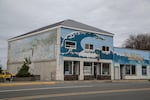This story is part of a series Oregon Public Broadcasting is doing on how well the Northwest is prepared for the magnitude 9.0 earthquake that scientists say will hit along the Cascadia Subduction Zone just off the Pacific Coast.
In this piece we look at:
- The challenges Curry County faces
- How Japan's earthquake experience changes everything
- Caught between tsunami waves and landslide slopes
- The politics of planning. Who's in charge?
- Why some in Curry County are 'Incredible Hulk ANGRY'
Gold Beach City Administrator Jodi Fritts was angry — or, as she put it in an email to state officials: "Incredible Hulk ANGRY."
She was one of several Gold Beach officials who had been working for months to finalize plans for re-building the local Curry General Hospital. They convinced local voters to support a bond measure to pay for it.

Jodi Fritts, City Administrator of Gold Beach. Fritts was one of several local officials who worked for months to secure plans and funding for a much needed replacement of Curry General Hospital.
Tony Schick/OPB
Then, in the spring of 2014, state officials from the Oregon Department of Geology and Mineral Industries (DOGAMI) started asking questions about the location that local officials had chosen for Curry General.
That's because the new hospital is to be built inside the state's proposed new tsunami zone.
"If there were ever a place for the state to step in and help, this is it," DOGAMI's Ian Madin wrote to other state officials. Madin is the agency's chief scientist.
This "place" is a small Southern Oregon town close to the California border and the Rogue River, that boasts wide open beaches and beautiful vistas.
Curry General stands about four blocks from the ocean. It has been declared an outdated fire hazard. It has only remained open thanks to waivers from the state fire marshal.

Curry General Hospital in Gold Beach. The hospital must be replaced by 2016 to meet fire codes, but the community only has the land and money to put its new hospital at the same site of the old one. However, scientists now know that site will take devastating tsunami damage in the event of Oregon's next major earthquake.
Tony Schick/OPB
So there's widespread agreement that the old building has to go. And local officials plan to build a new hospital on the same site — where the hospital's parking lot is now located.
There's only one problem: It's going to be rebuilt in an area that scientists now know is a tsunami zone.
So how did this happen? And why did public officials move forward with a multimillion dollar plan to build a hospital in a tsunami zone?
The answers are complex. They reflect new science around what a 9.0 Cascadia subduction earthquake would do to Oregon's coastal communities. That science has raised thorny political questions for local and state officials, trying to grapple with the reality of an earthquake of that magnitude -- the same magnitude that struck off the coast of Japan in 2011.
Scientists say there's no question that such an earthquake is coming here. The only thing they don't know is when that will be, but they estimate there's a 37 percent chance that a large magnitude event will strike sometime in the next 50 years off the Oregon coast.
Curry County: Aging Infrastructure, Aging Population, Limited Resources
Gold Beach is about 50 miles north of the California border. Curry Hospital serves not only Gold Beach, but the whole of Curry County and its population of 22,000.
Hospital officials and the city started serious planning to rebuild the hospital in 2012.
Curry General is not what you'd call a state-of-the-art facility. Construction started in 1949 and wings were added in the 1950s and 60s. It's an unreinforced brick structure, so won't survive the kind of 8 or 9 magnitude earthquake scientists are predicting along Oregon's coast.

Curry Health Network interim CEO Wayne Hellerstedt stands in the basement of Curry General Hospital. Outdated and in violation of state fire codes, the hospital is in dire need of an update. County voters approved a $10 million bond for a new hospital, but the only site being discussed is in an area of known tsunami hazards.
Tony Schick/OPB
The hospital doesn't meet today's fire standards either.
"The fire marshal has said we have until mid-2016 to build a replacement building or he's going to shut us down," said hospital interim CEO Wayne Hellerstedt.
"It's a one envelope building, which essentially means there are not fire or smoke breaks in the building," he said.
That means that if a fire breaks out in the kitchen, it can spread unhindered to the operating room, the wards, everywhere.
The hospital is also too small. The hospital staff stores X-ray machines and other medical equipment along the corridors. Machines and boxes pack the hospital labs.
Many of Gold Beach's residents are retirees on limited incomes — almost 30 percent are 65 or older, according to U.S. Census figures. When voters passed a $10 million bond to help pay for a new hospital, it was the first bond measure to have passed in 10 years.
City officials and hospital executives began planning for the new hospital in 2012. They consulted official state-issued tsunami maps — dating from 1995 — to plan where to place the new hospital building.
The state had just published a revised tsunami map for Gold Beach, showing the new hospital site would be in the tsunami zone. But that map, and others up and down the coast, have yet to be officially adopted by DOGAMI.
The local planners looked at a variety of sites. But they couldn't find a location that met all their criteria. They wanted the building to be centrally located, so patients who walk to the hospital could still get there.

A wave mural covers the facade of a building in downtown Gold Beach. Recently released maps from the Oregon Department of Geology and Mineral Industries show extensive tsunami inundation throughout Gold Beach in the scenario of the 9.0 megaquake due on the Northwest coast.
Tony Schick/OPB
Officials also looked at lots in the hills above Gold Beach, but rejected them for a variety of reasons. They worried about landslides and the cost of building a new road, sewer and electrical hook ups.
In the end, local officials decided to rebuild the hospital on the same lot as the existing, outdated building.
"We're staying in this area for two main reasons," Hellerstedt said. "The first one is budgetary. We just couldn't afford to get to the top of a hill, get it level, get a road that has the right grade to be able to handle vehicles to go up there. The cost is just prohibitive."
Hospital officials also want to make it easy for Gold Beach's older residents to get to the services they need, especially in emergency situations, like heart attacks.
"The second reason is that we want to be close to the town," Hellerstedt said.
New plans for the building also include high seismic standards, like piles being sunk deep under ground for stabilization in the event of a large quake. Important mechanics, like the HVAC system, will also be placed on the roof, to keep them as far away from any water as possible.
Japan's Experience Shifts Oregon's Earthquake And Tsunami Predictions
In 2011, a devastating 9.0 earthquake hit Japan. The world watched chilling video of the ensuing tsunami, as it pushed inland, rolling past buildings and over roads and flat coastal terrain. About 18,500 people died or went missing after the earthquake and tsunami.
Scientists in Oregon began reviewing what happened in Japan, to see if they could learn anything that might be relevant to the subduction zone that they predict will cause a massive earthquake off the coast of the Pacific Northwest.
The Cascadia Subuction Zone, as it's known, stretches from Northern California to Vancouver, B.C.
After conducting more research, the Oregon Department of Geology and Mineral Industries (DOGAMI) proposed pushing Oregon's coastal tsunami zone farther inland. The tsunami zone expansion has yet to be formally adopted by DOGAMI. But that revision now puts the area where Curry General hospital is located right in the midst of the tsunami zone.
The building is about 50 feet above sea level. Scientists estimate that waves from a 9.0 subduction earthquake off the coast of Oregon could reach between 60 and 100 feet above sea level.
By 2012, when the new tsunami zone estimates came out, the hospital already had approval from voters to raise money from a bond, and plans for the design. Hospital officials say it’s too late to change those plans now.
Between The Devil And The Deep Blue Sea
There's another wrinkle too.
The hills above Gold Beach would be prone to landslides during a magnitude 9.0 subduction earthquake. Scientists have also looked at what the land might do in those hills if a major earthquake struck. And when DOGAMI's map of areas that are prone to landslides is overlaid with the new tsunami map, there's little land left to locate a hospital outside either a landslide or tsunami zone.
Oregon's latest tsunami inundation maps cover most of the Gold Beach city limits. Just outside those limits is a hillside riddled with landslide hazards, which would also be triggered by a major earthquake. Source: DOGAMI.
DOGAMI Tsunami Inundation Map (TIM) Series
Gold Beach City Councilor Tamie Kaufman says at some point, all the planning in the world isn't going to help."If we get the 9.0 there won’t be a town anyway. We’re built on sand. It’s a river delta," she said.
Kaufman's talking about soil liquefaction. That's a phenomenon in which soil softens and loses strength under heavy shaking, making it very unstable.
"So our roads are going to be out. Our power’s going to be out. It's going to be devastating. It’s going to make Hurricane Katrina look like it was nothing," Kaufman said.
"So, can we build for that? No. We can’t prepare for that completely. We just hope that we have a resilient town, and we can get along and find a way to survive something that horrible," she added.
Kaufman says predictions are just that, predictions. Nobody knows when or where the next tsunami will hit. And meanwhile, she says, Gold Beach needs a new hospital to treat all the people who are having heart attacks and car accidents now.
"So, you know, it’s not crazy that we’re building there. I know it seems that way from the outside looking in, but it really isn’t," said Kaufman. "It’s a good location. It’s something we can afford. It’s something that’s been approved. And, they’re doing a great job of designing it to withstand as much as they can."
State vs. Local: The Politics Of Emergency Planning
For state emergency planners, what's happening with Curry General in Gold Beach is not good news.
Jay Wilson, chairman of the Oregon Seismic Safety Policy Advisory Commission, is responsible for statewide earthquake planning. He sees the siting process for the hospital at Gold Beach as a failure.
"Yes, I think we need to do a much better job in how we apply the science directly to the policies, the rules, the statutes, so that there isn't this huge gap in implementation."
He says critical facilities that provide life safety are being built without taking what scientists now know into account.
"Yeah, I would say the state needs to do a much better job there. And the public needs to hold the state accountable," said Wilson.
'Incredible Hulk ANGRY'
The disagreement between local officials, Curry General and the state came to a head in the spring of 2014.
In an email obtained by OPB and dated April 20, 2014, Ian Madin with DOGAMI wrote to other state officials saying, "This is where the rubber meets the road, and it's happening right now for these people, and they are from a poor county, and one that is relatively unsophisticated about these kinds of design challenges and risk assessments, and they want to do the right thing."
DOGAMI met with Gold Beach officials April 21, 2014, but it did not go well.
After that meeting, Gold Beach City Administrator Jodi Fritts, fired off her email May 8 to the state: "I'm angry. Incredible Hulk ANGRY."
Fritts is also the city's planning director. She went on to say, "I'm angry that computer models and projections are going to effectively prohibit development in my town without any local input. I'm angry that people that have never been to my county or my city are trying to make long-term financial and societal decisions about my town without listening to local input.
"I'm angry that state agencies think a natural disaster that may or may not happen in the next 100-1000 years is more DIRE than not having any hospital in my town or my entire county," she wrote.
Wilson, of the seismic safety policy group, believes true preparedness is still possible. He says that even though it might cost more to build outside the tsunami zone, the safest options may be even cheaper in the long run. He visited hospitals in Japan that withstood the 2011 earthquake.
The frustration level has calmed since the flurry of emails last spring. But the hospital is still scheduled to be built in its current parking lot, and within the new tsunami zone, by 2016.
